Griffiths D. Head First Statistics
Подождите немного. Документ загружается.


you are here 4 111
measuring variability and spread
Pool Puzzle
There’s an easier calculation for calculating the
variance, but what is it? Your job is to take
equation snippets from the pool, and
place them into the blank lines in the
derivation. Each snippet will be used
only once, but you won’t need to use
every one. Your goal is to get to the
equation at the end.
Note: each snippet
from the pool can only
be used once!
- 2μx
+ 2μx
Σμ
2
μ
See if you can
get from here...
to here.
μ
Σμ
Psst - here’s a hint.
Remember that
Σx
=
μ.
n
Σ(x - μ)
2
n
=
Σ(x - μ) (x - μ)
n
=
Σ(x
2
+ μ
2
)
n
=
Σx
2
- μ
2
n
=
n
-
2μ Σx
n
+
Σx
2
n
=
nμ
2
n
- 2μ
+
Σx
2
n
Σx
n
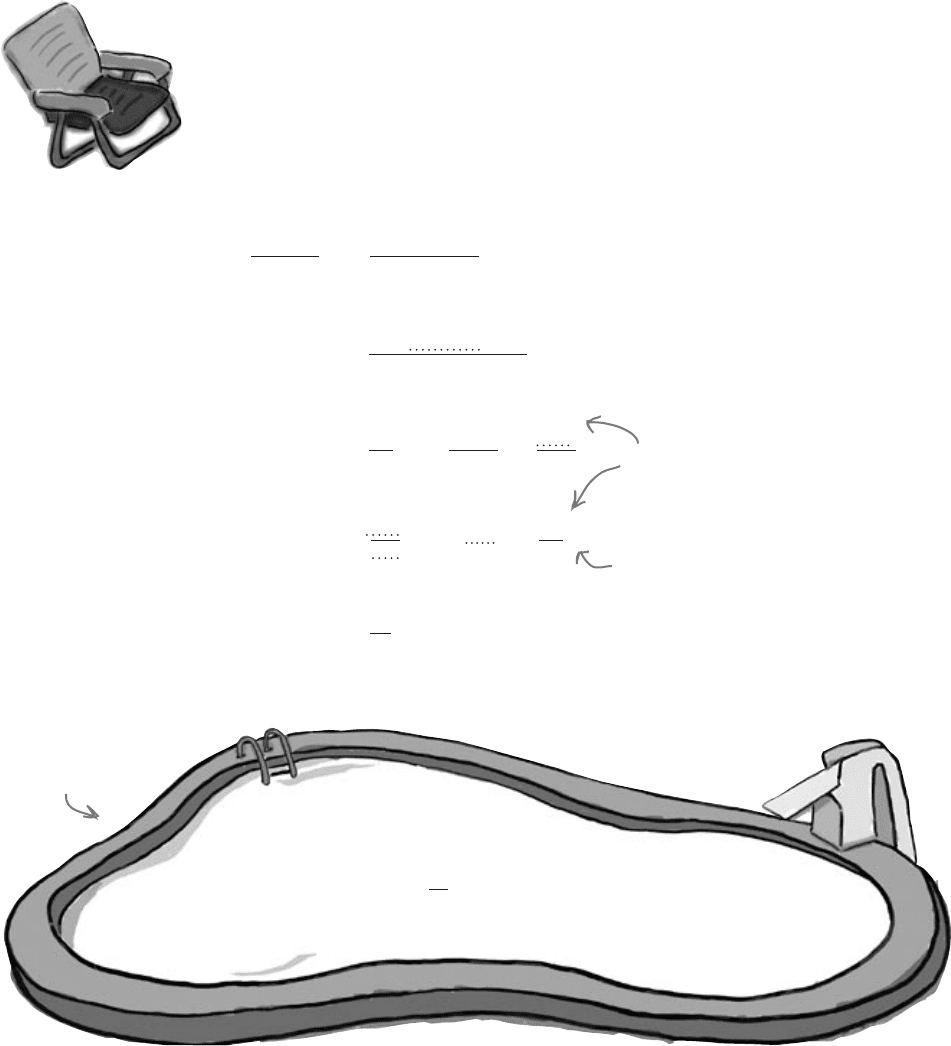
112 Chapter 3
You didn’t need
these snippets.
+ 2μx
μΣμ
Σ(x - μ)
2
n
=
Σ(x - μ) (x - μ)
n
=
Σ(x
2
+ μ
2
)
n
=
Σx
2
- μ
2
n
=
n
-
2μ Σx
n
+
Σx
2
n
Σμ
2
=
nμ
2
n
- 2μ
+
μ
There are n
of these.
The n’s here cancel
each other out.
Pool Puzzle Solution
There’s an easier calculation for calculating the
variance, but what is it? Your job is to take
equation snippets from the pool, and
place them into the blank lines in the
derivation. Each snippet will be used
only once, but you won’t need to use
every one. Your goal is to get to the
equation at the end.
pool puzzle solution
Σx
n
Σx
2
n
- 2μx
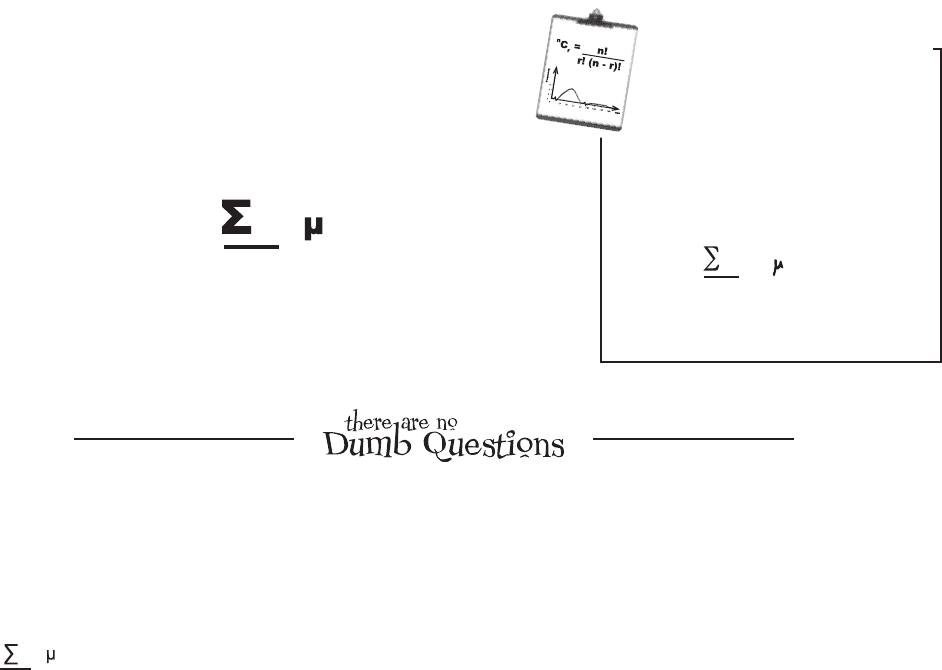
you are here 4 113
measuring variability and spread
A quicker calculation for variance
As you’ve seen, the standard deviation is a good way of measuring
spread, but the necessary variance calculation quickly becomes
complicated. The difficulty lies in having to calculate (x - μ)
2
for
every value of x. The more values you’re dealing with, the easier it
is to make a mistake—particularly if μ is a long decimal number.
Here’s a quicker way to calculate the variance:
The advantage of this method is that you don’t have to calculate
(x - μ)
2
. Which means that, in practice, it’s less tricky to deal with,
and there’s less of a chance you’ll make mistake.
Q:
So which form of the variance
equation should I use?
A: If you’re performing calculations, it’s
generally easier to use the second form,
which is:
This is particularly important if you have a
mean with lots of decimals.
Q:
How do I work out the standard
deviation with this form of the variance
equation?
A: Exactly the same way as before. Taking
the square root of the variance gives you the
standard deviation.
Q:
What if I’m told what the standard
deviation is, can I find the variance?
A: Yes, you can. The standard deviation
is the square root of the variance, which
means that the variance is the square of the
standard deviation. To find the variance from
the standard deviation, square the value of
the standard deviation.
Q:
I find the standard deviation really
confusing. What is it again?
A: The standard deviation is a way of
measuring spread. It describes how far typical
values are from the mean.
If the standard deviation is high, this means
that values are typically a long way from the
mean. If the standard deviation is low, values
tend to be close to the mean.
Q:
Can the standard deviation ever be 0?
A: Yes, it can. The standard deviation is
0 if all of the values are the same. In other
words, if each value is a distance of 0 away
from the mean, the standard deviation will
be 0.
Q:
What units is standard deviation
measured in?
A: It’s measured in the same units as
your data. If your measurements are in
centimeters, and the standard deviation
is 1, this means that values are typically 1
centimeter away from the mean.
Q:
I’m sure I’ve seen formulas for
variance where you divide by (n - 1)
instead of n. Is that wrong?
A: It’s not wrong, but that form of the
variance is really used when you’re dealing
with samples. We’ll show you more about this
when we talk about sampling later in the book.
Variance =
x
2
-
2
n
x
2
-
2
n
Variance
Here’s the quicker way of
calculating the variance
Vital StatisticsVital Statistics
x
2
-
2
n
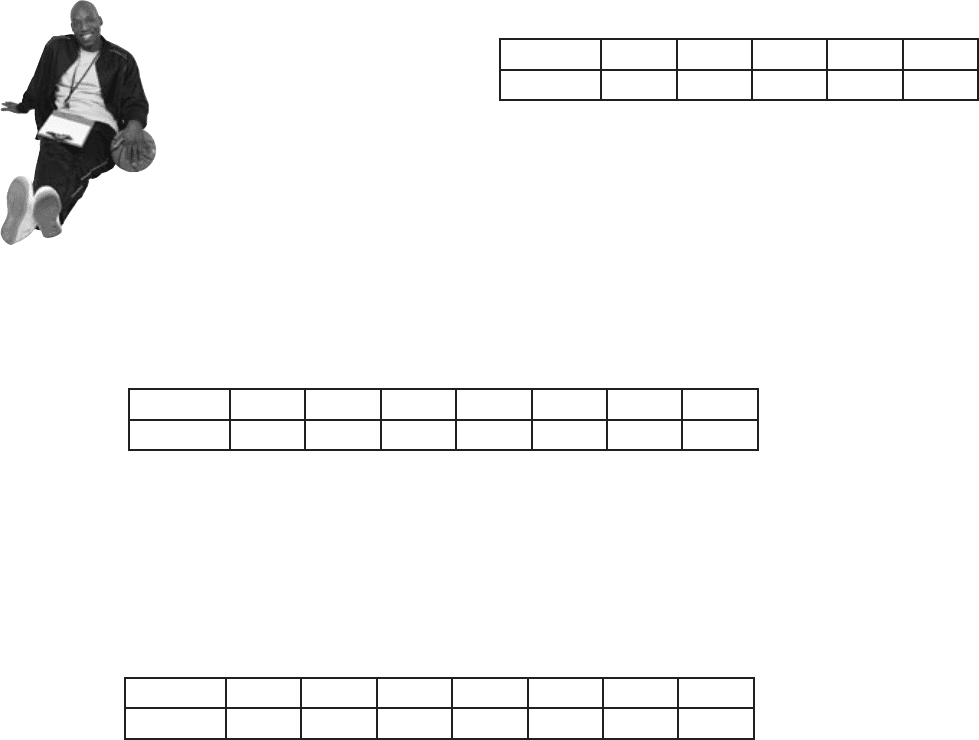
114 Chapter 3
Score 7 9 10 11 13
Frequency 1 2 4 2 1
Player 1
BE the coach
Here are the scores for the
three players. The mean for
each of them is 10. Your job
is to play like you’re the
coach, and work out the
standard deviation for each
player. Which player is the
most reliable one for your team?
Score 7 8 9 10 11 12 13
Frequency 1 1 2 2 2 1 1
Player 3
Player 2
Score 3 6 7 10 11 13 30
Frequency 2 1 2 3 1 1 1
be the coach

you are here 4 115
measuring variability and spread
The generous CEO of Starbuzz Coffee wants to give all his employees a pay raise. He’s not sure
whether to give everyone a straight $2,000 raise or increase salaries by 10%.
a) What happens to the standard deviation if everyone at Starbuzz is given a $2,000 pay raise?
b) What happens to the standard deviation if everyone at Starbuzz is given a 10% pay raise instead?
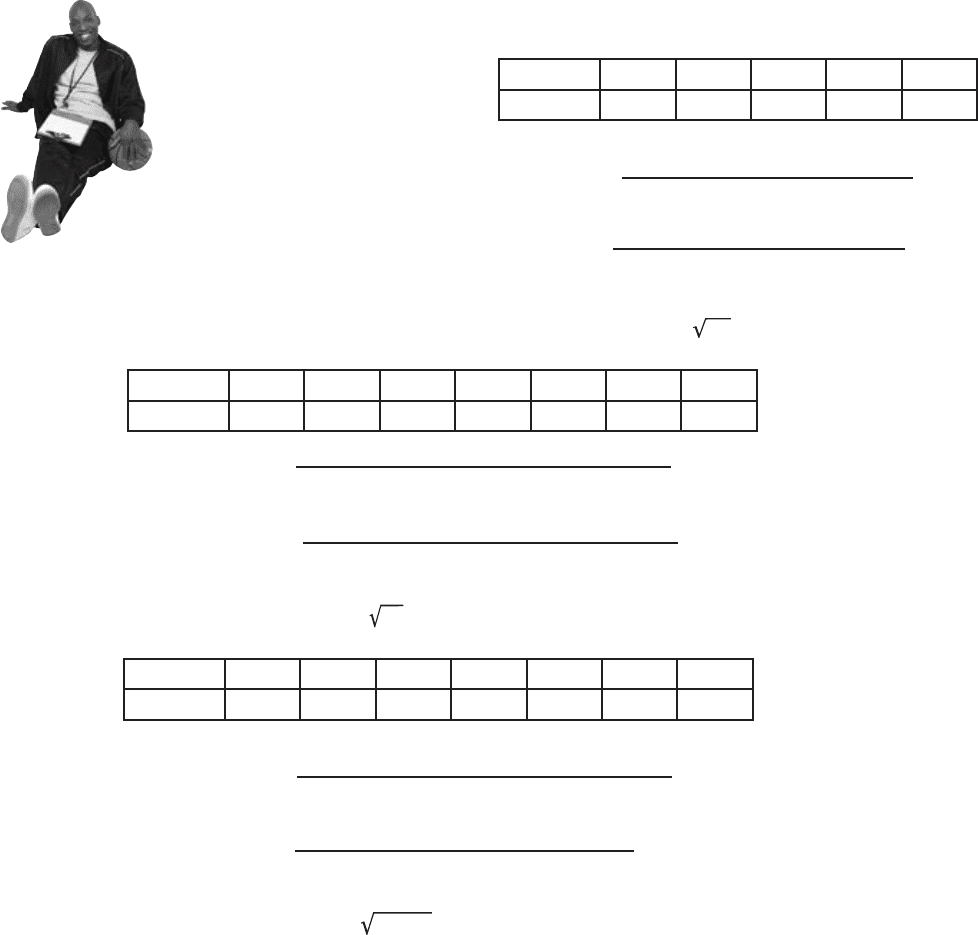
116 Chapter 3
Score 7 8 9 10 11 12 13
Frequency 1 1 2 2 2 1 1
Player 3
Player 2
Variance = 7
2
+ 2(9
2
) + 4(10
2
) + 2(11
2
) + 13
2
10
= 49 + 162 + 400 + 242 + 169
10
= 2.2
Standard Deviation = 2.2 = 1.48
Player 1 and Player 2 both have small standard deviations, so the values are
clustered around the mean. But Player 3 has a standard deviation of 7.02,
meaning scores are typically 7.02 points away from the mean. So Player 1 is the
most reliable, and Player 3 is the least.
BE the coach Solution
Here are the scores for the
three players. The mean for
each of them is 10. Your job
is to play like you’re the
coach, and work out the
standard deviation for each
player. Which player is the
most reliable one for your team?
Score 3 6 7 10 11 13 30
Frequency 2 1 2 3 1 1 1
Score 7 9 10 11 13
Frequency 1 2 4 2 1
Player 1
be the coach solution
-100
-100
Variance = 7
2
+ 8
2
+ 2(9
2
) + 2(10
2
) + 2(11
2
)
+ 12
2
+ 13
2
10
= 49 + 64 + 162 + 200 + 242 + 144 + 169
10
= 3
Standard Deviation = 3 = 1.73
-100
-100
Variance = 2(3
2
) + 6
2
+ 2(7
2
) + 3(10
2
) + 11
2
+ 13
2
+ 30
2
11
= 18 + 36 + 98 + 300 + 121 + 169 + 900
11
= 49.27
Standard Deviation = 49.27 = 7.02
-100
-100
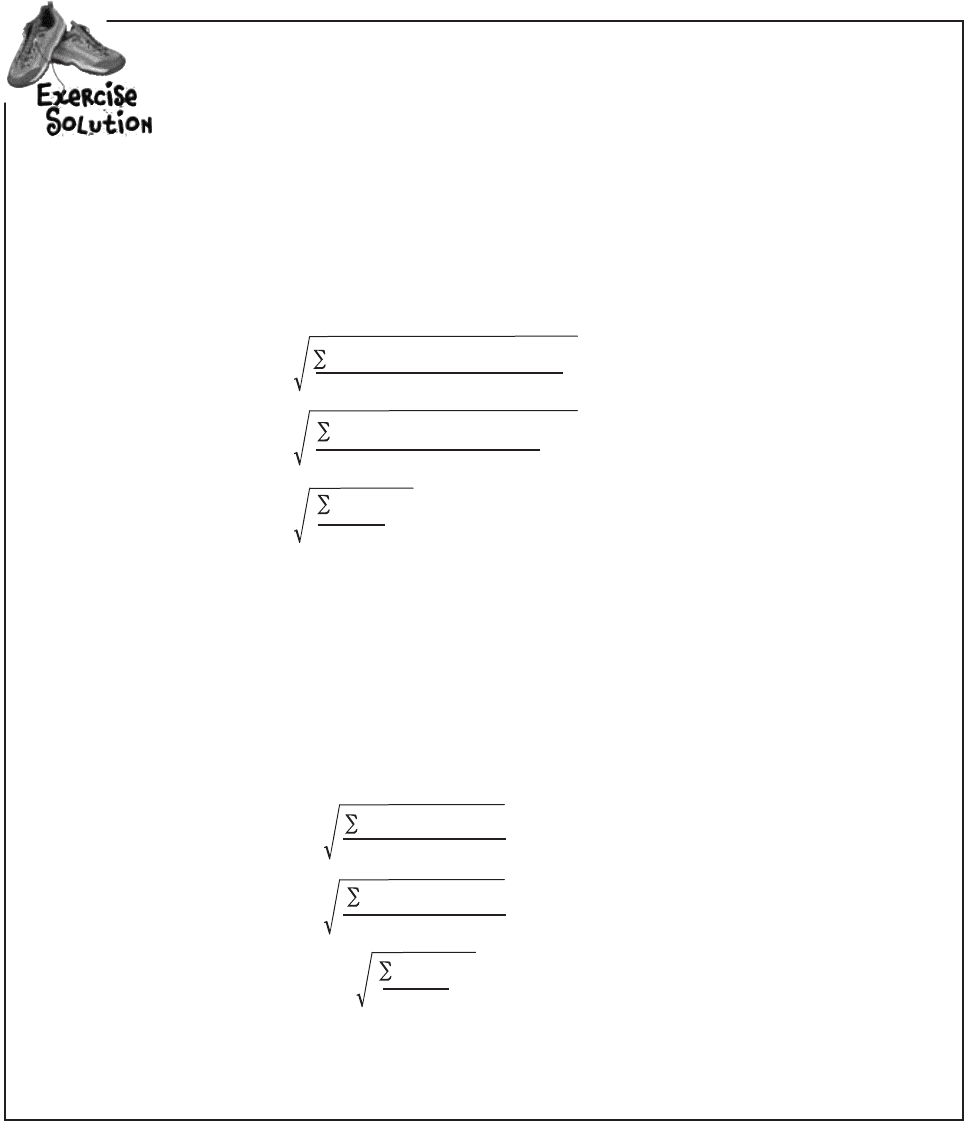
you are here 4 117
measuring variability and spread
The generous CEO of Starbuzz Coffee wants to give all his employees a pay raise. He’s not sure
whether to give everyone a straight $2,000 raise or increase salaries by 10%.
a) What happens to the standard deviation if everyone at Starbuzz is given a $2,000 pay raise?
b) What happens to the standard deviation if everyone at Starbuzz is given a 10% pay raise instead?
The standard deviation is multiplied by 110%, or 1.1. The figures are stretched,
so the standard deviation increases.
standard deviation = ((1.1x) - (1.1μ))
2
= 1.1
2
(x - μ)
2
= 1.1 (x - μ)
2
= 1.1 times original standard deviation
n
n
n
The standard deviation stays exactly the same. The figures are, in effect, picked up
and moved sideways, so the standard deviation doesn’t change.
standard deviation = ((x + 2000) - (μ + 2000))
2
= (x + 2000 - μ -2000)
2
= (x - μ)
2
= original standard deviation
n
n
n

118 Chapter 3
That’s easy—Player 1
does best. Player 1 scores 75%
of the time, and Player 2 only
scores 55% of the time.
What if we need a baseline for comparison?
We’ve seen how the standard deviation can be used to measure how variable a
set of values are, and we’ve used it to pick out the most reliable player for the
Statsville All Stars. The standard deviation has other uses, too.
Imagine a situation in which you have two basketball players of different ability.
The first player gets the ball into the net an average of 70% of the time, and he
has a standard deviation of 20%. The second player has a mean of 40% and a
standard deviation of 10%.
In a particular practice session, Player 1 gets the ball into the net 75% of the
time, and Player 2 makes a basket 55% of the time. Which player does best
against their personal track record?
Just looking at the percentages doesn’t give
the full picture.
75% sounds like a high percentage, but we’re not taking into account the
mean and standard deviation of each player. Each player has scored more
than their personal mean, but which has fared better against their personal
track record? How can we compare the two players?
The two players have different
means and standard deviations,
so how can we compare their
personal performance?
Does this sort of situation sound impossible? Don’t worry, we can achieve
this with the standard score, or z-score.
Player 1
Player 2
μ = 70
μ = 40
σ = 20 σ = 10
55
75
Percentage Percentage
standard scores
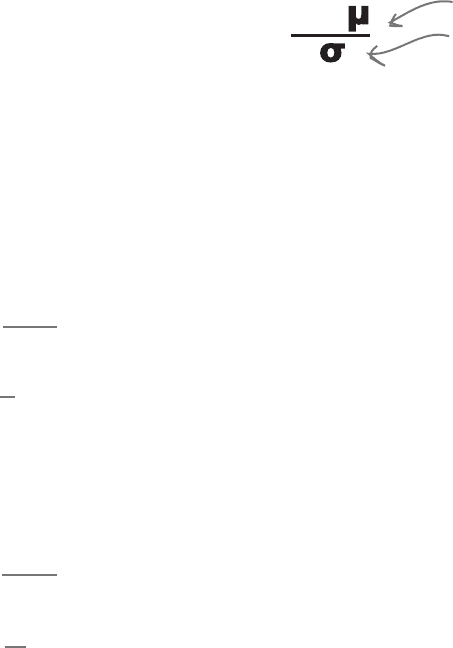
you are here 4 119
measuring variability and spread
Standard scores give you a way of comparing values across different sets of data
where the mean and standard deviation differ. They’re a way of comparing
related data values in different circumstances. As an example, you can use
standard scores to compare each player’s performance relative to his personal
track record—a bit like a personal trainer would.
You find the standard score of a particular value using the mean and standard
deviation of the entire data set. The standard score is normally denoted by the
letter z, and to find the standard score of a particular value x, you use the formula:
Calculating standard scores
Let’s start by calculating z
1
, the standard score of Player 1.
z
1
= 75 - 70
20
= 5
20
= 0.25
So using the mean and standard deviation to standardize the score,
Player 1 gets 0.25. What about the score for Player 2?
z
2
= 55 - 40
10
= 15
10
= 1.5
This gives us a standard score of 1.5 for Player 2, compared with a
standard score of 0.25 for Player 1. But what does this actually mean?
These are the mean and
standard deviation of the
set of data containing the
value x.
Let’s calculate the standard scores for each player, and see what those
scores tell us.
Use standard scores to compare values across data sets
x -
z
=
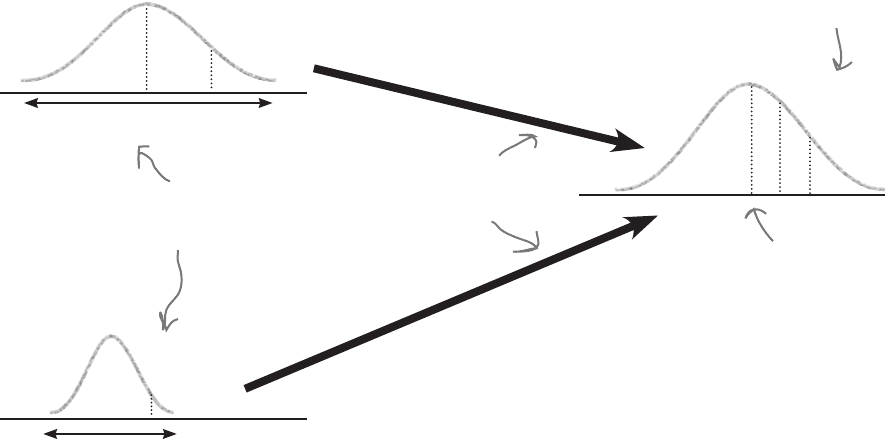
120 Chapter 3
Interpreting standard scores
Standard scores give us a way of comparing values across different data sets even when the
sets of data have different means and standard deviations. They’re a way of comparing
values as if they came from the same set of data or distribution.
So what does this mean for our basketball players?
Each player’s shooting success rate has a different mean and standard deviation, which
makes it difficult to compare how the players are performing relative to their own track
record. We can see that in a particular practice, one player got the ball in the net more
times than the other. We also notice that both players are scoring at a higher rate than their
average. The difficulty lies in comparing performances relative to the personal track record
of each player.
The standard score makes such comparisons possible by transforming each set of data into
a more generic distribution. We can find the standard score of each player at the practice
session, and then transform and compare them.
So what does this tell us about the players?
The standard score for Player 1 is 0.25, while the standard
score for Player 2 is 1.5. In other words, when we
standardize the scores, the score for Player 2 is higher.
This means that even though Player 1 is generally a better
shooter and put balls into the net at a higher rate than
Player 2, Player 2 performed better relative to his own track
record. Player 2 performed better…for him.
interpreting standard scores
Player 1
Player 2
Z
μ = 70
μ = 40
σ = 20
σ = 10
55
75
It’s difficult to
compare these two
data sets directly.
But we can
compare them with
z-scores.
z
1
= 0.25
z
2
= 1.5
Super-generic data
distribution Z
These are the
standard scores
for the two
players.
